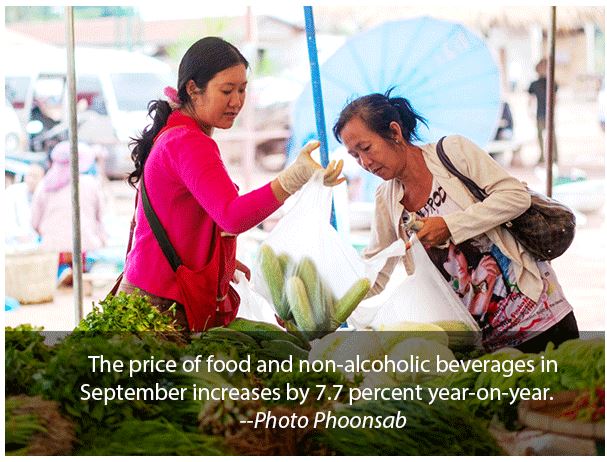Laos: Inflation remains high in September
The Consumer Price Index (CPI) declined in September compared to the previous month but was still high, creating further hardship for people struggling to rise out of poverty.
According to a report from the Lao Statistics Bureau, the CPI stood at 114.97 points in September, resulting in an inflation rate of 4.63 percent, down from the 5.84 percent recorded in August.
It is no surprise that inflation is driven by the rising price of food and other imported products because Laos imports more than it exports.
Fluctuation in currency exchange rates is one of the main reasons for the inflated cost of living in Laos because many traders rely on parallel markets to buy the foreign currencies they need to import goods.
The Covid-19 pandemic is also disrupting exports, the inflow of foreign visitors and foreign investment in Laos, which are considered to be the main sources of Laos’ foreign currency earnings.
In addition, domestic productivity is not as strong as it should be due to the fact that Laos has to import large amounts of machinery and other equipment, further impacting product prices.
The price of food and non-alcoholic beverages increased by 7.7 percent year-on-year and by 0.45 percent month-on-month.
This was largely attributed to the fact that Laos buys huge quantities of food from neighbouring countries, including seafood. In addition, the rainy season made it difficult for farmers to grow sufficient crops to meet market demand.
The price of pork surged by 26.32 percent year-on-year, beef by 11.62 percent, poultry by 6.02 percent, fish and seafood by 5.15 percent, cooking oil by 5.99 percent, fruit by 4.4 percent, and vegetables by 14.88 percent.
The rate in the clothing and footwear category rose by 3.89 year-on-year, with clothing increasing by 4.15 percent year-on-year.
The cost of household goods went up by 0.39 percent month-on-month and 4.87 year-on-year. The price of interior décor items including furniture surged by 7.7 percent year-on-year and kitchen items by 3.8 percent.
Prices in the medical care category climbed by 0.17 percent month-on-month and 5.66 percent year-on-year, while the cost of post and telecommunication services rose by 6.59 percent.
Meanwhile prices in the restaurant and hotel category dropped by 2.09 percent year-on-year due to the Covid-19 epidemic.
Last year, the inflation rate averaged 3.32 percent, according to the Bank of the Lao PDR. Inflation soared to 6.94 percent in January this year before dipping to 6.24 percent in February, 6.14 percent in March, 5.84 percent in April, 5.46 percent in May, 5.28 percent in June, 5.12 percent in July and then rising to 5.84 percent in August.
According to the Lao Statistics Bureau, the value of the kip fell by 4.29 percent against the US dollar and 10.3 percent against the Thai baht in July, compared to the same month last year.
The government is attempting to cap rising food prices by pushing for greater domestic productivity to minimise the need for imports.
However, the volume of goods produced in Laos does not come close to meeting market demand, and large quantities of food items must still be imported from Thailand.
Source: http://www.vientianetimes.org.la/freeContent/FreeConten_Inflation_195.php


 Thailand
Thailand




